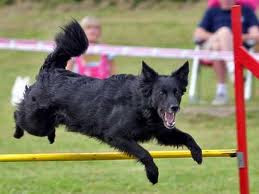The Croatian Sheepdog is a very old working breed from the Balkans, believed by some to had accompanied proto-Croats on their supposed journey from Afghanistan to Europe, but this theory has yet to be proven. A number of enthusiasts trace the Croatian Sheepdog to the Greek Alopekis, while others link this energetic little worker directly to the black Asian wolves. It should be noted that many other theories concerning this breed's ancestry exist, from it being a descendant of the Hungarian Mudi to the Croatian Sheepdog actually being Mudi's ancestor, as well as the progenitor of most European herders and spitz dogs.
Most of these claims are made by the overly-zealous fanciers in Croatia and are generally disregarded as nationalist fantasies, designed to distance the breed from its true heritage, which is firmly rooted in the ancient Serbian working dog known as the Pulin.
Being a variety of the old Pulin, the breed presently recognized as the Croatian Sheepdog is in fact older than the Hungarian Mudi and could be considered to be one of its indirect ancestors, but it has also been influenced by Mudi's blood periodically. One of the most celebrated working dogs of the area, the Croatian Sheepdog has remained virtually unchanged since the 1300's, when it was considered to simply be a Slavonian variety of the Serbian Pulin breed, belonging to a specific type of the greater Pannonian Herder population.
By the 18th century, the Slavonian Pulin could be found all over Slavonia, northern Bosnia, Serbia and parts of Croatia and Istria, where it finally became known as the Croatian Pulin, although other names remained in use well into the 1900's, such as the Panonski Svinjar, Brodski Bujdar, Slavonski Ovcar, Pujdar, Ravnicarski Govedar and others. Although existing in a few types, the Croatian Sheepdog is
a remarkably uniformed breed in terms of overall recognizable appearance, but more importantly in its personality traits and working qualities.
This rugged dog has traditionally been used to herd, control and protect pigs, cows, sheep, goats and other farm animals, including ducks and geese, as well as occasionally being employed as capable small game hunter, described as terrier-like in personality. Prized for its courage and resilience, but also its handsome appearance, the Croatian Sheepdog was gaining popularity during the first two decades of the 20th century as a superb watchdog and good companion in its homeland, resulting in a dedicated effort to select the best representatives of the breed form around the country and start a strict breeding programme which would eventually lead to proper standardization and recognition.
The most prized bloodlines have traditionally been from the areas of Djakovo and Slavonski Brod, but other strains were used in this historic breeding, too. From the beginning of the programme in the mid 1930's to the breed's first appearance at a Dog Show in 1949, the fanciers of the Croatian Sheepdog were successful in establishing the breed type and in the 1950's the Standard was written, with the breed initially bearing the name Ravnicarski Ovcar, before finally being officially recognized by the FCI in 1969 as the Hrvatski Ovcar.
Brave, intelligent and alert, the Croatian Sheepdog is a trainable and affectionate family pet, but also an impressive property guardian and livestock herding dog. This is a tough, feisty and athletic little dog, ideally suited for Agility trials. Early socialization is important to keep its strong territorial nature and somewhat unfriendly attitude towards strange dogs under control. The Hrvatski Ovcar is a fairly light, but well-boned, muscular and strongly built breed, with sturdy legs, powerful neck, deep chest and broad shoulders.
Although the breed has been standardized, there are still different types to be found within the working population, where the dog's physical appearance isn't as important as it is for Show dogs, so some examples that are heavier or taller than preferred by the Standard can be encountered. The Croatian Sheepdog has fox-like facial features and small erect ears, but specimens with semi-pricked or even drop-ears could be found up until the late 1980's, but they're fairly rare today.
The great majority of the dogs are born with either short tails or fully bobtailed, but many examples have full-length tails, which are usually docked for work. The coat is very dense and harsh, flat on the face, but coarse and curly on the body, although wavy-coated dogs exist, as well as some flat-coated representatives. Although oddly coloured dogs are sometimes seen, such as black-n-tan, black-n-white, brown, cream and white examples, the only accepted colouring for the Hrvatski Ovcar is uniform black, with minimal white markings allowed on the feet and chest. Average height is around 18 inches, but taller specimens exist.















Well done for the text. Very honestly written.
ReplyDeleteIn Serbia, we have been raising dogs of this breed for centuries - Pulin. Slavonia was once predominantly inhabited by a Serbian population that had been expelled on several occasions. Dogs of this breed were with Serbs. For political reasons in communist Yugoslavia, the dog belonged to Croatia. Even today, Croats go to Serbia to get dogs of this breed.
Only 20 years ago, the Hungarians printed postage stamps with their dog breeds, and they didn't have a Mudi. Apparently, they didn't even know they had it.
It is the most developed breed in Serbia, but the poor cynological organization in Serbia does nothing to recognize the breed, nor to recognize the Serbian shepherd dog and some other breeds.